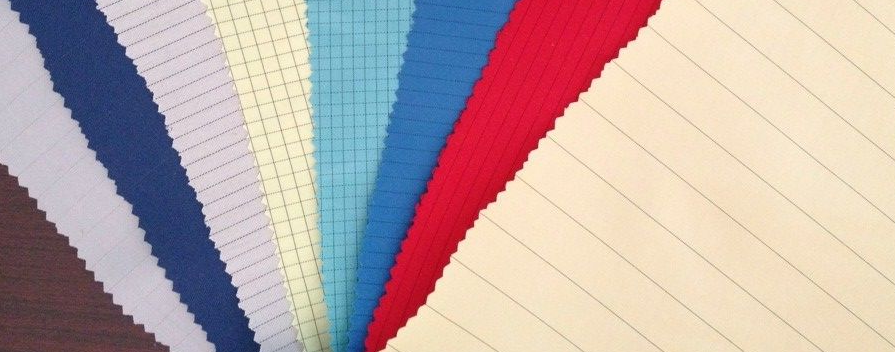Popular knowledge about anti-static cloth

Generation and harm of static electricity
(1) Static electricity generation: When any object is exposed to other contact and then separated, the electrons are detached from the orbit by external force. This external force contains various energies (such as kinetic energy, potential energy, thermal energy, chemical energy , electromagnetic induction, etc.) can generate static electricity.
(2) Static electricity hazard: When the static charge generated by an object accumulates and forms a high potential, a high potential difference will be formed when it comes into contact with other uncharged objects. And discharge phenomenon occurs. When the voltage reaches more than 300 volts, the generated static sparks can ignite surrounding combustible gases, liquids, and dust, causing an explosion! Static electricity has seriously harmed all areas of people’s production and life, such as military industry, fire industry, petroleum, natural gas, chemical industry, shipping, production of sensitive materials, coal mines, rubber, medicine, gas, etc.; another example is the fuel tank storage department, electronics, etc. Device manufacturing, microelectronics related industries, mechanical electronics, complete electronics, office automation, information communications, electronic medical, computer and other industries
Basic classification of anti-static cloth
(1) Anti-static silk (conductive silk) and anti-static ultra-clean fabric
(2) Anti-static T/C fabric
(3) Anti-static T/R fabric
(4) Anti-static CVC fabrics, etc.
(5) Anti-static Cotton fabric
Anti-static finishing method for fabrics
(1) Fabrics are finished with antistatic finishing agents;
(2) Fiber graft modification and blended chemical fiber fabrics with hydrophilic fibers for the purpose of improving fabric hygroscopicity;
(3) Blended chemical fiber fabric or inlaid conductive fiber;
The mechanism of action of the first two methods is to increase the moisture regain of fabrics, reduce insulation, and accelerate electrostatic leakage. Therefore, if the finishing effect is “not durable or not noticeable” in a dry environment or after multiple cleanings, it is usually used on general workwear fabrics. Only the third method can permanently and efficiently solve the static problem of fabrics, so it is widely used in the production of anti-static workwear fabrics.
The difference between conductive silk fabric and blended chemical fiber fabric
(1) The conductive threads in conductive yarn fabrics are mainly embedded in the back of the fabric. The back of the fabric is a semiconductor, and the front of the fabric is an insulator. What is removed is only the static electricity generated by the friction between the work clothes and the human body. It cannot remove the static electricity generated by the friction with external equipment. There is still charge accumulation on the front of the work clothes.
(2) Blended chemical fiber fabrics are made by adding conductive fibers to the yarn during the fabrication process. Both the front and back of the fabric are semiconductors, which can quickly and evenly remove the waste generated by the human body and work clothes. The static electricity and the static electricity generated on the surface of the work clothes when in contact with the outside world, the work clothes have no charge accumulation. At present, we commonly use conductive yarn fabrics.
The difference between black silk and white silk
(1) White silk: metal oxide polyester conductive fiber
(2) Black silk: Carbon black and metal oxide laminated polyester conductive.
Sizing: Since conductive filaments are expensive, the warp beam embedded with conductive filaments is placed on a creel near the sizing tank ( The double-layered shaft frame should also be placed on top.) Firstly, it can reduce the waste of waste yarn of the conductive filaments embedded in the warp. Secondly, it can be easily viewed. The conductive filaments embedded in the warp should be arranged evenly at intervals, and the twisted wires must be threaded before dropping the shaft.
Weaving: Like 2/1 twill and 3/1 yarn card, the corresponding 1/2 and 1/3 weaving methods are generally used (because the conductive yarn is used in conventional 2/1 or 3/1 weaving) The floating points are more obvious on the front of the fabric. Customers generally require that the conductive thread should not be exposed on the front of the fabric. However, the effect is significantly improved after adopting the 1/2 or 1/3 process, so that the customer’s requirements can be basically met.
td>
AAASDFDNHGCXE
Disclaimer:
Disclaimer: Some of the texts, pictures, audios, and videos of some articles published on this site are from the Internet and do not represent the views of this site. The copyrights belong to the original authors. If you find that the information reproduced on this website infringes upon your rights, please contact us and we will change or delete it as soon as possible.
AA







